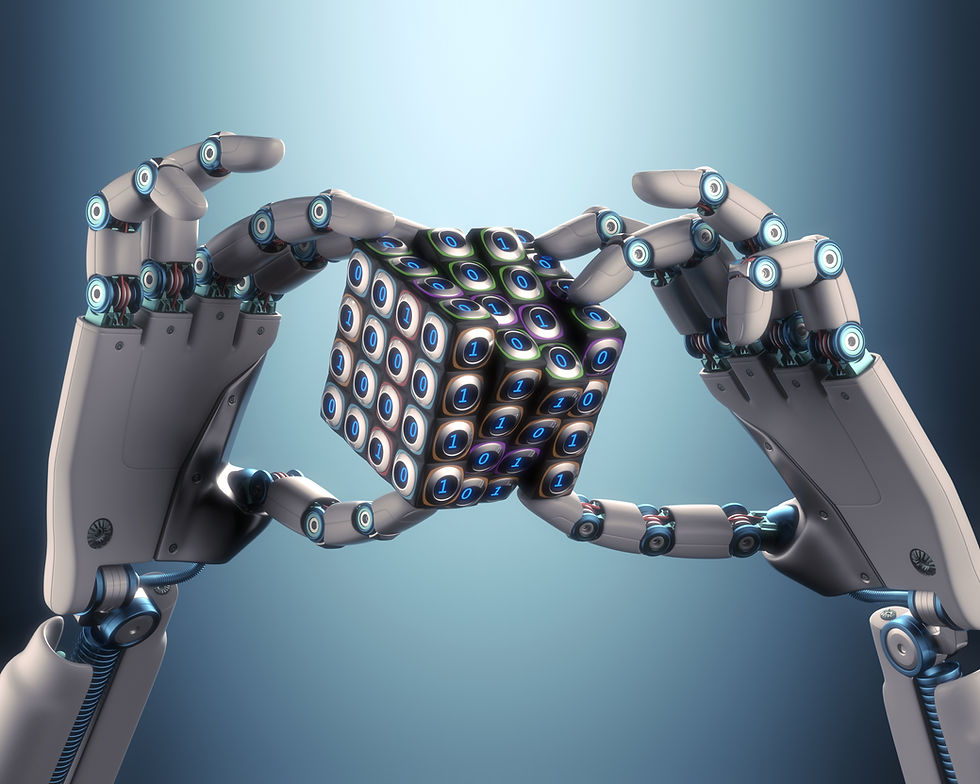AI and Art: A Collaboration or Total Takeover?
- Marina Chisty

- Jun 4, 2024
- 4 min read

Although I don’t use AI to create my artwork, I am fascinated by the idea that one day AI could evolve to have a form of consciousness, be free-thinking and could revolutionize creativity (if this has not already happened).
AI developing a spark of consciousness is terrifying for many. Especially with influential people such as Elon Musk believing it could mark humanity’s downfall.
What is AI’s role in the art world? Should it just be seen as data processing software used by an artist and valued in the same way as other creative software? Or does its ability to make predictions, recommendations, or decisions through statistical reasoning change its status into being a collaborative tool that deserves its own citation? At what point will AI be creative in its own right and considered a sole author?
Artists Collaborating with AI
These are some recent exhibitions that showcased artists that explore the integration of art and technology through the use of AI.
1# Refik Anadol, Echoes of the Earth: Living Archive, Serpentine Gallery, UK

In a recent exhibition at the Serpentine Gallery in London, artist Refik Anadol created an immersive and sensorial experience. Echoes of the Earth: Living Archive, featured large-scale AI-generated artworks. The artist used visual data of coral reefs and rainforests, collected using technologies such as LiDAR and photogrammetry. The work Artificial Realities: Coral, was a sound and video experience created by sourcing approximately 135 million images of coral that are considered openly accessible online.
#2 AI: More than Human, Barbican Centre, UK
Back in 2019, an exhibition at the Barbican Centre in London, AI: More than Human, explored creative and scientific developments in AI, and the evolving relationship between humans and technology.
I especially liked the work of artist Anna Ridler whose work Myriad (Tulips) showed thousands of hand-labeled photographs of tulips which were later used as the dataset for a moving image work called Mosaic Virus 2018. Instead of showing the AI generated final artwork she used the photographs to show the level of manual labor required to create and construct AI artwork. Often people imagine (and I think sometimes it’s true) that making AI generated artwork is an artist being lazy: not thinking, not having to do any work – artwork at a click of a button. Her work in the exhibition exposed the human element in machine learning.
#3 Beyond the Light, ARTECHOUSE, NYC

Working alongside NASA scientists Beyond the Light interpreted collected data and brought it to life using creative technology. The immersive experience was developed using AI-aided visual production and an original musical score created from the collected data. The imagery was created using data collected from the James Webb telescope. I included this exhibition because the experience was awe inspiring and created an overwhelming sense of human achievement and the incredible discoveries our civilization has made. Through every new technological advancement, we get a little closer to the stars and see more of the universe.
#4 AI Surrealism, NYC
In 2023, Superchief Gallery NFT and collective Exquisite Workers, put together the exhibition AI Surrealism in NYC which was billed as the largest exhibition of its kind showing 100 artists that embrace AI-assisted creativity. The collective, Exquisite Workers, explore the intersection of surrealism and new technologies. To see the scale of artists working with AI was quite overwhelming. The artworks flipped between a dystopian horror show and utopian dreamscapes which is generally how I feel about the current and future human interactions with AI.
Will AI destroy Art?
At this stage it is quite difficult to say if human creativity will be destroyed by AI. It seems that the artwork being appreciated by humans still requires human intelligence, creativity and touch to at least be the initial spark and continued driver of the work.
When I discuss this topic with other creative professionals (writers, poets, graphic designers, filmmakers and artists), the main list of fears that come up are the following:
“AI is putting creative professionals out of work!”Creative writing and design jobs are already under threat, now generative AI can create images from written prompts. Why bother to seek out and pay for art when your computer can do it for you at a fraction of the price? Maybe this is how painters felt when photography came along and they feared it would render them defunct? I think once the initial excitement flares up people will crave an artist's touch again. We have already seen a lot of AI generated artwork and the novelty in many forms may wear off.
“What about intellectual property?”AI is often trained by sourcing images and files from the internet which has been a cause of concern in terms of intellectual property. However, this also takes me back to fears and debate about college artists using snippets from magazines and reimagining them into new artworks. This time it is happening digitally by what feels like a secret network of underground bots.
What are your fears about AI? Please share them below in the comments.




Commenti